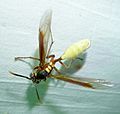Apoica pallens facts for kids
Quick facts for kids Apoica pallens |
|
|---|---|
 |
|
| A. pallens observed in Panama | |
| Scientific classification | |
| Synonyms | |
|
The Central American paper wasp (Apoica pallens) is a special type of wasp that is active at night. It lives in large groups, like a big family or colony. These wasps are known for their amazing swarming behavior. They come from the lowlands of central and northern South America.
This wasp species has developed special features that help them see well in the dark. These features are useful for their night-time swarming and when they go out to find food. The Apoica pallens wasp is also important to the Pankararé people in Brazil for its traditional uses.
Contents
Where They Live
Apoica pallens wasps live in the lowlands of Central and northern South America. You can usually find them in places like tropical savannas, dry forests where some trees lose their leaves, and wet marshland areas. The Apoica group of wasps is very common in the tropical parts of the New World.
Swarming Behavior
Apoica pallens is famous for how its colonies move. This is called "swarm founding." It means that all the adult wasps in a colony leave their old nest together and fly to a new spot. This can happen for a few reasons.
- Sometimes, it's just a normal part of how the colony grows and makes new colonies.
- Other times, they move because their old nest was badly damaged or destroyed.
- Moving nests can also be linked to changes in the weather. For Apoica pallens, this happens more often during the dry season.
Male wasps will follow these swarms and might stay with the new colony for a few weeks.
Other Cool Behaviors
Finding Food at Night
These wasps look for food when it's dark outside. Swarms of wasps will suddenly leave the nest, then quickly come back, only to leave again in the same way. As the night goes on, smaller groups of wasps keep leaving and returning.
How Apoica pallens finds food depends on the moon’s cycle.
- When the moon is new (dark), they forage during the first four hours after sunset. They also have a small burst of activity just before dawn as they return to the nest.
- When the moon is getting brighter (waxing), they stay out longer, sometimes all night long.
Their special adaptations help them find food even when there's not much light. These wasps have a wider view compared to their relatives.
Wasp Roles in the Colony
Apoica pallens has different types of females, like different jobs in a team. These are called "castes." They are workers and queens. You can tell them apart by the size of their ovaries.
The differences between queens and workers start when they are still larvae (baby wasps). Larvae that will become queens grow faster in some body parts than those that will become workers. This means they end up with slightly different shapes, even if they were the same size as larvae.
Traditional Uses
In some parts of Brazil, people use insects in their traditional medicine. These insects are used to help treat different health issues. The nests of Apoica pallens are very important to the Pankararé people and other rural communities in Brazil.
Sometimes, the wasp nests are burned, and people breathe in the smoke. This is believed to help with certain health issues. Also, if someone believes they have bad luck, they might bathe in the smoke from a burning nest as a spiritual treatment. In a place called Matinha dos Pretos, pieces of the nest might be boiled in water to make a tea. This tea is used to help with asthma.
What They Eat
Apoica pallens collects different small creatures like flies, caterpillars, and beetles. They also gather pollen and nectar from banana blossoms.
These wasps sometimes eat their own young, which is called "brood cannibalism." This happens if the adults don't have enough food for themselves. Usually, several adults will share one larva. Also, adult wasps share food with each other by passing it mouth-to-mouth. This is called "trophallaxis."
How They Defend Themselves
Apoica pallens uses active defense, not chemicals, to protect its nest. During the day, when the adult wasps are not out swarming, they cover the front of their nest in several layers. The wasps on the outside layer face outwards. They watch for ants or other predators trying to get into the nest. Scientists think that this way of protecting the nest during the day is why these wasps started to forage and swarm at night.
Images for kids
See also
 In Spanish: Apoica pallens para niños
In Spanish: Apoica pallens para niños





